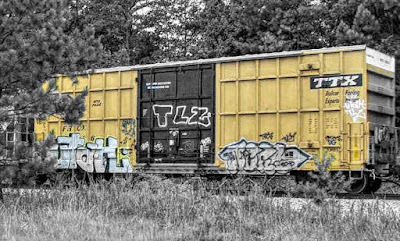I'm not a huge fan of graffiti. Certainly it distresses me when I see it on trains or buildings. It seems to me to be only artistic litter. And yet, there is also something compelling about it. Maybe it's that the voice of the voiceless is crying out from rain darkened streets from the depths of poverty and oppression, the medium being the message, as Marshall McLuhan would say. If we were to put words to the pain of graffiti in poetry it'd be Allen Ginsberg's poem Howl's opening lines:
I saw the best minds of my generation destroyed by madness, starving hysterical naked,I noticed at Thanksgiving when I was re-organizing my photos into folders, that I have apparently taken a lot of graffiti photos over the years. Huh.
dragging themselves through the negro streets at dawn looking for an angry fix,
Angel-headed hipsters burning for the ancient heavenly connection
to the starry dynamo in the machinery of night,
In the store when I leafed through Naar's book, I saw that the photos themselves were stupendous. Eyes and faces and fists and art and life and streets and subway tunnels, not howling naked but vibrant and saying something. This guy can take a picture. I bought the book. After all, I could not go wrong for $1.
When I researched Naar I discovered that the man is a renowned photojournalist. I learned that his book The Birth of Graffiti was a follow-up to his (and Normal Mailer's) seminal and culturally ground-breaking book The Faith of Graffiti. I definitely had a find on my hands.
Naar's Wikipedia entry states-
Jon Naar is a British-American author and photographer celebrated for his pioneering images of New York City graffiti in the 1970s. Still active in his nineties, Naar has had a multifaceted career as an intelligence officer in World War II; a globe-trotting executive during the postwar years; and an environmentalist, with nine published books to date.It seems now with this new information that his book selling for only a dollar is a crime. Some of his work hangs in the Metropolitan Museum of Art for heaven's sake!
Of his book The Birth of Graffiti, Wikipedia says-
By the 1970s, Naar's reputation was well established and he was redirecting his energies toward on-location corporate work for a diverse range of clients. Then in 1972, a commission for the London-based design firm Pentagram morphed into a full-length book project, with the 1974 release of The Faith of Graffiti (UK title Watching My Name Go By)—the first book-length examination of New York City graffiti art. Featuring an introduction by novelist Norman Mailer, the controversial collection would become "like a bible to later graffiti artists," in the words of Brian Wallis, chief curator at New York's International Center of Photography. Naar "legitimized" graffiti "a decade earlier than anyone else, and he came at it with a graphic design sensibility—he understood color and composition and bold design." It is for this groundbreaking series that Naar himself remains in demand, with numerous recent retrospectives and a 2007 collection, The Birth of Graffiti, which includes 130 previously unpublished photographs from the original assignment.Oh my. I definitely, definitely had a find on my hands. There is minimal text in Naar's book, just an introduction, and then the photos speak for themselves. And they do speak. His work is colorful, artistic, voicing the minds and hearts of a generation of graffiti artists/vandals now grown and gone. Graffiti wasn't born in NYC in the late 1960s-early 1970s, that happened in Philly in the late 50s-early 60s. But graffiti came to popular culture in NYC during the cultural revolution and in effect that is where it was really born or at least came to consciousness to the eyes and horror of America. And NYC Mayor John Lindsey who went to war on graffiti, a howling suit shaking fists at empty spray cans and running feet...
Here are a few of my own graffiti shots.
The moral of the story is, when you shop at an eclectic second hand store, keep your eyes open, peer into the untraveled corners, and take your time!





No comments:
Post a Comment